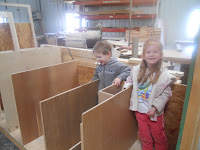What exactly is homemade food? It seems strange that we have to ask that question. But in our culture today, homemade means different things to different people. At a women's website recently, a survey was taken on what women considered homemade, and the answers were remarkably varied:
1. Homemade means anything made in the home, from "assembled" packages of frozen dinners, to processed box items, or even heated-up restaurant foods.
2. Homemade means only items raised at home, processed at home, and then cooked at home.
3. Homemade means any meal made with only natural or organic ingredients.
4. Homemade means any items cooked or baked at home using any kind of ingredients from scratch, but does not include pre-packaged items (like brownie mixes).
Homemade to me is kind of a mix of some of the above ideas. While a lot of what we eat is raised or grown here at home, then processed here at home (chickens for example) and then cooked here at home, there are obviously a lot of things I can not raise or grow here at home. So my next choice would be to use mostly natural or organic ingredients, but I find that can be financially restricting and sometimes out right impossible. The nearest 'organic' seller we have where we live is a good 60 mile round trip, and even then it is extremely limited to only a couple of selections of fruits and vegetables and no meat choices at all. So I have found myself to be a 'local food' scrounger, and while I enjoy the challenge of finding folks close by that are growing foods or raising animals that I can purchase, it's sometimes exhausting with my work schedule here at home with our business. In those cases, the next best thing is to try to find the best ingredients I can. Homemade to me does not mean processed foods like macaroni and cheese in a box, brownie or cake mixes, or cans of fruits and vegetables. That doesn't mean I don't use those things sometimes, it just doesn't mean "homemade" to me.
If you are going to start making homemade food, there are a few things you should know about, or you might as well be eating at a fast food joint or a greasy spoon. These ideas are brief and perhaps over-simplistic, so if you want to know more about these individually, do a good internet search, check out www.thehealthyhomeeconomist.com, www.westonaprice.org, or read Nourishing Traditions by Sally Fallon.
1. Use the best oils. Vegetable oils are bad fats. You need the best fats --coconut oil, olive oil, palm oil. Use real butter. Get rid of the crisco. Get rid of the margarine or oleo. Animal lard is good.
2. Use the best sweetener. Raw honey is the best. You can both cook and bake with honey instead of white or brown sugar. Honey is full of nutrients and vitamins, while white sugar has none. Artificial sweeteners are bad for you. Stevia and real maple syrup is a good option as well.
3. Use stainless steel cookware. Or cast iron. The cheap stuff gives off noxious fumes or flecks of metal into your food. Aluminum can actually be absorbed into your food when you cook with that metal. You must cook at lower temperatures with stainless and is more expensive, but it's better for you and your health.
4. Use whole grains. None of that white flour. It's best to freshly grind your wheat every time you use it because it can quickly go rancid (and did you know that when you do buy white flour it has to be frozen first to get rid of the bugs?). Better yet, sprout or soak your grains, nuts ,and beans before using.
5. Use lean proteins, organic/free range/humanely raised. This does not include hot dogs, luncheon meats, etc. Don't get any meat that has an ingredient list to it!
6. Stay away from processed foods. Processed foods can't be real food. There are mile-long ingredient lists for these foods that you can't possibly even understand what's in there. Many items are fake and man-made additives. Processed foods come in boxes, cans, cellophane bags, plastic jugs, etc. and are found typically in the middle aisles of a grocery store. Processed foods have expirations that date far into the future. If you must have these, use them as emergency foods for disasters, etc.
4. Use whole grains. None of that white flour. It's best to freshly grind your wheat every time you use it because it can quickly go rancid (and did you know that when you do buy white flour it has to be frozen first to get rid of the bugs?). Better yet, sprout or soak your grains, nuts ,and beans before using.
5. Use lean proteins, organic/free range/humanely raised. This does not include hot dogs, luncheon meats, etc. Don't get any meat that has an ingredient list to it!
6. Stay away from processed foods. Processed foods can't be real food. There are mile-long ingredient lists for these foods that you can't possibly even understand what's in there. Many items are fake and man-made additives. Processed foods come in boxes, cans, cellophane bags, plastic jugs, etc. and are found typically in the middle aisles of a grocery store. Processed foods have expirations that date far into the future. If you must have these, use them as emergency foods for disasters, etc.











